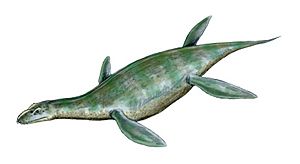Umoonasaurus facts for kids
Quick facts for kids Umoonasaurus |
|
|---|---|
 |
|
| Umoonasaurus demoscyllus from the Early Cretaceous of Australia | |
| Scientific classification | |
| Genus: |
Umoonasaurus
|
| Species: |
demoscyllus
|
Umoonasaurus was a type of plesiosaur, a large reptile that lived in the sea a long, long time ago. It is now extinct, meaning it no longer exists. This amazing creature lived about 115 million years ago. That was during the Late Cretaceous period.
Umoonasaurus swam in shallow seas that covered parts of what is now Australia. It was a fairly small animal for a plesiosaur, growing to about 2.5 meters (8 feet) long. A special feature of Umoonasaurus was the three crests on its head.
Discovery and Naming
The first Umoonasaurus demoscyllus fossil found is called the holotype. It was given the special name "Eric." This fossil is an opalized skeleton. This means it turned into opal over millions of years.
"Eric" was found in an opal mining area called Zorba Extension Opal Field. This field is near the town of Coober Pedy in Australia. The fossil is very well preserved. It is the most complete opalized fossil of a vertebrate (an animal with a backbone) ever found.
Other Umoonasaurus fossils have also been found. One was discovered in the Andamooka opal fields. Another was found near Lake Eyre. A young Umoonasaurus fossil was found near the Neales River. All these fossils come from a rock layer called the Bulldog Shale in South Australia.
The name Umoonasaurus comes from two parts. "Umoona" is the local Antakirinja name for the Coober Pedy area. "Sauros" is a Greek word meaning "lizard."
The second part of its name, demoscyllus, also comes from Greek words. "Demos" means "of the people." "Scylla" means "sea monster." This name was chosen because people donated money to help buy the first fossil, "Eric."
Description
Umoonasaurus was a small plesiosaur. Plesiosaurs were marine reptiles with four flippers. The main fossil, "Eric," was about 2 to 2.5 meters (6.5 to 8 feet) long. A fossil of a young Umoonasaurus was only about 70 centimeters (2.3 feet) long.
Umoonasaurus had a small, triangle-shaped skull. It was about 22.2 centimeters (8.7 inches) long. It had a tall, narrow crest along the front middle of its skull. There were also two other ridges above its eyes.
Its mouth had long, sharp teeth. These teeth were good for catching slippery prey. The nostrils were very small and close to its eyes.
The bones in its neck were taller than they were wide. Its ribs were single-headed. The bones in its flippers were wider than they were long. The last few bones in its tail were joined together. Scientists think this might have helped support a fin on its tail.
What it Ate and How it Lived
The crests on Umoonasaurus' head were probably covered in a tough material called keratin. This would have made them look even taller. These crests were likely too thin for fighting or defense.
Scientists believe the crests were used for communication. They might have helped Umoonasaurus recognize others of its own kind. They could also have been used in courtship displays to attract a mate. These crests might have been brightly colored.
Fossils of Umoonasaurus have shown gastroliths (stomach stones) and fish bones inside them. This tells us that Umoonasaurus ate small fish. It did not have features for hunting very large prey.
Where it Lived
All known Umoonasaurus fossils come from the Bulldog Shale. This rock layer is found in the Eromanga Basin in South Australia. The rocks here formed about 115 million years ago. This was during the early Aptian stage of the Lower Cretaceous period.
Some parts of the Bulldog Shale, like around Coober Pedy, have rich opal deposits. This is why the "Eric" fossil turned into opal.
The Bulldog Shale shows that this area was once a shallow inland sea near the coast. The water at the bottom of this sea had low oxygen.
This sea was located far south, near the polar region. The climate was seasonal, with very cold temperatures. Evidence like glendonite (a mineral that forms in cold water) and ice-rafted boulders (rocks carried by ice) shows this. The average temperature was around 12.2°C (54°F). This means Umoonasaurus could live in cold water.
Many other fossils have been found in the Bulldog Shale. These include plants, invertebrates (like belemnites and molluscs), fish (like chimaeras and lungfish), and other reptiles. Other plesiosaurs like Opallionectes and the giant Kronosaurus also lived there. The ichthyosaur Platypterygius was also found in these rocks.
See also
- In Spanish: Umoonasaurus para niños

